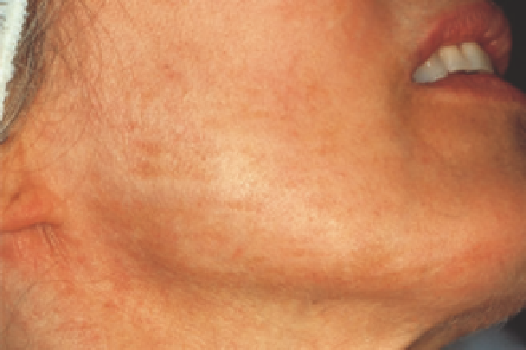Biomedical Engineering Reference
In-Depth Information
(
A
)
(
B
)
Figure 6.13
(
A
) Relatively superfi cial lines may be completely removed by ablating to depth of wrinkle line. (
B
) Improvement depends on ablation of solar elasto-
sis and wound healing. Collagen shrinkage and new collagen formation are not necessary for this improvement to occur.
Figure 6.15
Single pass of computer pattern generator may result in linear
streaks of hyperpigmentation, resulting from differential thermal effects leav-
ing a mixture of non-sun-damaged cells and sun-damaged cells. To prevent
this, a second pass is performed at 90° to fi rst pass.
Figure 6.14
Initial CO
2
laser pass effectively removes epidermis by vaporizing
a 40- to 50-
m layer and causing a subepidermal vesicle to form. Surface is
covered with white, desiccated, proteinaceous debris from epidermis immedi-
ately after fi rst pass. This needs to be wiped away with saline-soaked gauze.
μ
remains visible over the entire treatment area, the entire area is
treated again. In general, however, the third pass is confi ned to
the glabellar area, upper lip, nasolabial folds, and lateral cheeks.
A fourth pass with the Lumenis CPG is only rarely needed
except in cases of advanced, severe photodamage and is there-
fore not recommended (Fig. 6.3).
Generally, after the third pass with the Lumenis CPG, treat-
ment with the 3-mm beam is used in selective areas to fl atten
high tissue points by vaporization and to tighten loose skin or
ablate wrinkles by pulling the base of wrinkle lines up and
achieving as smooth a surface as possible to act as a base for
new collagen formation.
In performing resurfacing, clinicians should keep in mind
the following:
individual laser impacts within the pattern should have mini-
mal overlap (generally densities of 3-6).
The surface is covered with a single pass of laser impacts,
resulting in white, desiccated debris composed of protein-
aceous epidermal tissue remaining after intracellular tissue
water vaporization (Fig. 6.14). This tissue debris should be
wiped away with saline-moistened gauze to remove the
remaining epidermis. The fi rst pass generally removes the
epidermis and leaves only minimal residual thermal damage
(10-30
m) depending on epidermal thickness, with more
thermal damage in thin epidermis, such as eyelid or neck skin.
This procedure is repeated over the entire surface to be treated
for the second pass. The only difference is that during this pass,
the CPG is oriented at 90° to the direction used for the fi rst
pass. The reason for this is to avoid the appearance of linear
pigment streaks that may be associated with the pattern of the
CPG (Fig. 6.15).
Generally, the third pass is applied more selectively to areas of
more signifi cant photodamage and wrinkling. If photodamage
μ
1. Always “feather” the peripheral areas by decreasing
the density of pulse application as well as the pulse
energy (decrease to 200-250 mJ), or angle the beam
at 45° to spread the fl uence over a larger surface area.
2. Feather into the hairline a distance of 5-15 mm
and well under the jawline (3-5 cm) (Fig. 6.16).
















